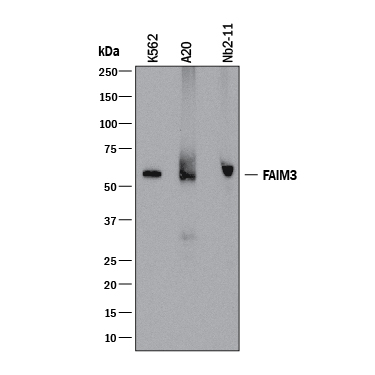Human/Mouse/Rat Fc mu R/FAIM3 Antibody Summary
Arg18-Gly251
Accession # O60667
Applications
Please Note: Optimal dilutions should be determined by each laboratory for each application. General Protocols are available in the Technical Information section on our website.
Scientific Data
 View Larger
View Larger
Detection of Human, Mouse, and Rat Fc mu R/FAIM3 by Western Blot. Western blot shows lysates of K562 human chronic myelogenous leukemia cell line, A20 mouse B cell lymphoma cell line, and Nb2-11 rat lymphoma cell line. PVDF membrane was probed with 2 µg/mL of Mouse Anti-Human/Mouse/Rat Fc mu R/FAIM3 Monoclonal Antibody (Catalog # MAB9494) followed by HRP-conjugated Anti-Mouse IgG Secondary Antibody (Catalog # HAF018). A specific band was detected for Fc mu R/FAIM3 at approximately 60 kDa (as indicated). This experiment was conducted under reducing conditions and using Immunoblot Buffer Group 1.
 View Larger
View Larger
Detection of FAIM3 in HEK293 Human Cell Line Transfected with Human FAIM3 and eGFP by Flow Cytometry. HEK293 human embryonic kidney cell line transfected with (A) human FAIM3 or (B) irrelevant transfectants and eGFP was stained with Mouse Anti-Human/Mouse/Rat FAIM3 Monoclonal Antibody (Catalog # MAB9494) followed by APC-conjugated Anti-Mouse IgG Secondary Antibody (Catalog # F0101B). Quadrant markers were set based on control antibody staining (Catalog # MAB0041). View our protocol for Staining Membrane-associated Proteins.
Reconstitution Calculator
Preparation and Storage
- 12 months from date of receipt, -20 to -70 °C as supplied.
- 1 month, 2 to 8 °C under sterile conditions after reconstitution.
- 6 months, -20 to -70 °C under sterile conditions after reconstitution.
Background: Fc mu R/FAIM3
The human FAIM3 gene (also known as FCMR or TOSO), is a transmembrane sialoglycoprotein expressed mainly by lymphocytes. FAIM3 is a type I membrane protein with an intracellular C-terminal domain and an extracellular N-terminal domain (1). The extracellular domain has homology to the immunoglobulin variable region domains (1) and FAIM3 is identified as an Fc receptor for IgM (2, 3). The amino acid sequence of human FAIM3 is 58% and 55% identical to that of mouse and rat FAIM3, respectively. FAIM3 was shown to be over-expressed in chronic lymphocytic leukemia (CLL) (4) and associated with disease progression (5, 6). FAIM3 has also been linked to the homeostasis and activation of the innate immune system (7). Interestingly, there is growing evidence that neurodegenerative diseases are associated with the activation of the immune surveillance system. This system is responsible for controlling danger signals and responding accordingly to the magnitude and duration of the threat (8, 9).
- Song, Y. et al (2005) J. Biol. Chem. 280(10):9618.
- Shima H et al. (2010) Int. Immunol. 22:149.
- Kubagawa H et al. (2009) J. Exp. Med. 206:2779.
- Proto-Siqueira R et al. (2008) Blood, 112:394.
- Pallasch, C et al. (2008) Blood, 112:4213.
- Pallasch, C P et al (2009) Leukemia & lymphoma, 50:498.
- Sigruener, A et al (2007) Biochemical and biophysical research communications, 359:723.
- Richards R I et al (2016) Front. Neurosci. 10:193.
- Planells-Ferrer L et al (2016) J Neurochem. 139:11.
Product Datasheets
FAQs
No product specific FAQs exist for this product, however you may
View all Antibody FAQsReviews for Human/Mouse/Rat Fc mu R/FAIM3 Antibody
There are currently no reviews for this product. Be the first to review Human/Mouse/Rat Fc mu R/FAIM3 Antibody and earn rewards!
Have you used Human/Mouse/Rat Fc mu R/FAIM3 Antibody?
Submit a review and receive an Amazon gift card.
$25/€18/£15/$25CAN/¥75 Yuan/¥2500 Yen for a review with an image
$10/€7/£6/$10 CAD/¥70 Yuan/¥1110 Yen for a review without an image

